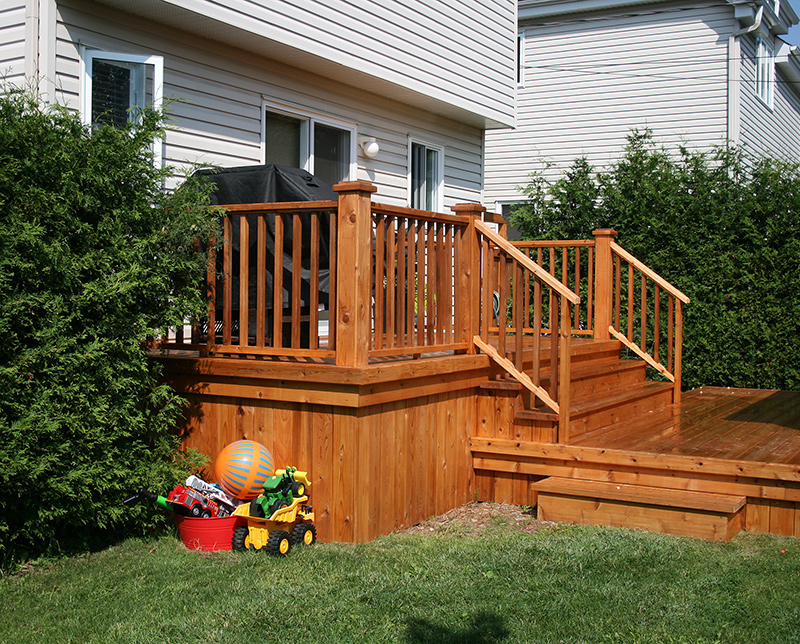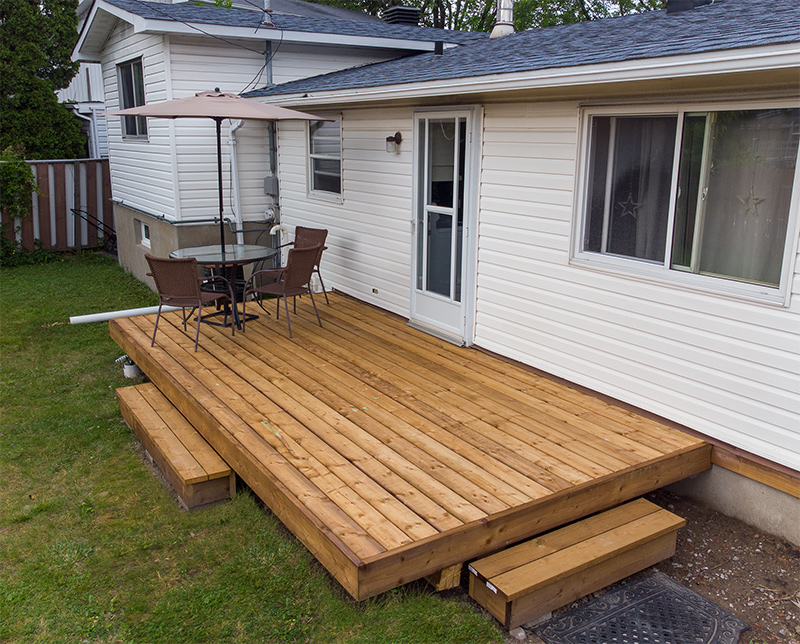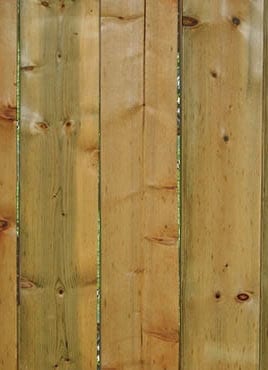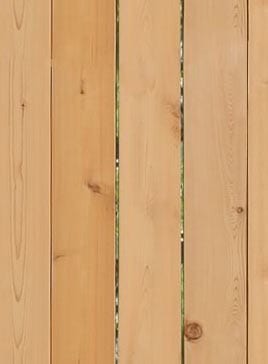
Cedar Sun Deck

Pressure Treated Sun Deck
The WOOD CHOICES here refer to the condition of the material at the time of delivery. There is no guarantee offered or implied with regard to any wood product.
NOTE: Many customers are surprised to learn that wood might start to change as early as the same day the product arrives. These flaws do not wait to develop a year or even a month after installation. They generally start to show with a change in the weather.
Customers who worry about natural flaws are STRONGLY encouraged to consider other types of material. Wood is the only building material we offer with NO Warranty.
#2 Pressure Treated Lumber
For those people working with a tighter budget a popular alternative is Pressure Treated Lumber. PT is NOT offered as a #1 Grade–purchasers should expect #2 Grade.
Brown or Green PT simply refers to the choice of tint in the chemical used to “treat” the wood. Because of the gummy sap and the wide variety of characteristics inherent to each of the different types of wood that are used, customers should be aware that the colour is inconsistent with this economical type of lumber.
Knot holes should be limited to no more than 2 holes on any piece (maximum 3/4″ diameter) along with an unlimited number of sound knots. Bark, eased edges, warping, cupping and cracking should all be expected.
Further warping, cupping, twisting, and cracking after construction (possibly in as little as a day or two) is also to be expected with this type of wood.
The main point to remember: #2 Grade is about economy over aesthetics.

#1 Grade Western Red Cedar
After more than 40 years, #1 Western Red Cedar continues to be the most popular choice of customers for all of our wood products.
There may be one small knot hole (less than 3/4” in diameter) in any piece but an unlimited number of sound knots (each being no more than 1/2 the width of the piece).
Bark is not permitted but there may be missing edges that run for up to 1/4 the length of any piece.
Some amount of warping, cupping, twisting, and cracking is to be expected but these defects should not be obvious from 30′ away once the piece is set into place.

Douglas Fir
Douglas fir and cedar are both softwoods that are easy to work with, but they have different strengths and are used for different purposes:
- Appearance: Douglas fir has a clean, consistent look with a reddish brown tone that darkens over time. Cedar has a richer color palette and more distinctive grain, ranging from pale reddish brown to golden hues.
- Durability: Cedar is more resistant to weather and insects than Douglas fir, but treated Douglas fir can be just as long-lasting in many applications.
- Strength: Douglas fir is stronger than cedar and is better for structural uses.
- Cost: Douglas fir is priced to match Cedar.
- Ease of use: Both species are easy to fix, glue, and finish.
- Maintenance: Cedar requires low maintenance.
- Installation: Cedar is easy to install.
Here are some other things to consider when choosing between Douglas fir and cedar:
- Density: Cedar is slightly denser than Douglas fir, which can make it slightly more durable.
- Scratch resistance: Both species are prone to damage from bumps and abrasion.
- Decking: Cedar is a good choice for a deck because of its natural durability, low maintenance, and aesthetic appeal.
- Pavilions: Douglas fir can be used to build pavilions that last for decades with proper maintenance.
Moderate warping, twisting, and minor checking are common and accepted within the grade but should not detract from the overall appearance when viewed from a distance of 25 feet or more once installed.
More on Cracks in Large Timber:
How do you prevent cracks in your large timbers? Easy answer: you can’t…
https://www.mcilvain.com/how-to-prevent-cracks-in-your-large-timbers/
A Note Regarding Colours of Western Red Cedar:
For Fence and Railing Posts we try to only select the heartwood of coastal cedar (darker coloured wood from the centre of the trees) for it’s stronger protection against rot.
For the rest of the dimensions we try to choose interior cedar (lighter coloured cedar) for it’s smaller, tighter knots.
